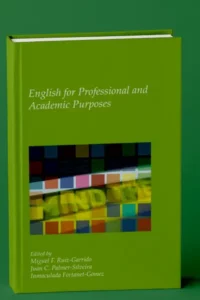English for Professional and Academic Purposes PDF
“English for Professional and Academic Purposes” by Miguel Farias and Margarita Vinagre is an excellent guide for anyone who wants to improve their English language skills in a professional or academic setting. The book is designed for non-native English speakers who need to use English in their work or academic life.
The book is divided into three parts. Part One focuses on the language skills needed for professional and academic purposes, such as writing emails, giving presentations, and participating in meetings. Part Two focuses on specific areas of academic study, such as science, engineering, and humanities. Part Three provides additional resources for further study, such as online resources, books, and articles.
One of the strengths of this book is its practical approach. The authors provide clear and concise explanations of grammar, vocabulary, and other language skills needed for professional and academic communication. They also provide numerous examples and exercises to help readers practice these skills in a variety of contexts.
For example, in Chapter 3, the authors discuss how to write effective emails. They provide a clear explanation of the structure of an email, including the greeting, body, and closing. They also discuss the importance of using appropriate language, such as formal or informal language, depending on the context. Finally, they provide several examples of emails and exercises to help readers practice writing effective emails.
In addition to the practical approach, the book also provides valuable insights into the cultural aspects of professional and academic communication. For example, the authors discuss the differences between American and British English and provide tips for using language appropriately in each context. They also provide information on cultural differences in communication styles, such as direct versus indirect communication.
One of the challenges of using English in a professional or academic setting is the specialized vocabulary needed for different fields. Part Two of the book addresses this challenge by providing specific vocabulary and language skills for different fields of study, such as engineering, science, and humanities. The authors provide clear explanations and examples of the language used in each field, as well as exercises to help readers practice using this language.
Overall, “English for Professional and Academic Purposes” is an excellent resource for non-native English speakers who need to use English in their work or academic life. The book’s practical approach, clear explanations, and numerous examples and exercises make it a valuable tool for anyone looking to improve their English language skills.
The book is also suitable for use in a classroom setting. The authors provide a teacher’s guide, which includes additional exercises and activities to supplement the material in the book. This makes it a useful resource for English teachers who are looking for materials to use in their classes.
In conclusion, “English for Professional and Academic Purposes” is an excellent guide for anyone looking to improve their English language skills in a professional or academic setting. The book’s practical approach, clear explanations, and numerous examples and exercises make it a valuable resource for non-native English speakers, as well as English teachers looking for materials to use in their classes. I highly recommend this book to anyone looking to improve their English language skills.
English for Academic and Professional Purposes topics
- Contents……Page 6
- Current trends in English for Professional and Academic Purposes……Page 8
- Section I Discourse analysis of English for academic purposes……Page 16
- Formality in academic writing: The use/non-use of phrasal verbs in two varieties of English……Page 18
- The ‘dialectics of change’ as a facet of globalisation: Epistemic modality in academic writing……Page 32
- Hidden influencers and the scholarly enterprise: A cross-cultural/linguistic study of acknowledgments in medical research articles……Page 50
- Researching into English for research publication purposes from an applied intercultural perspective……Page 64
- Section II Discourse analysis of professional English……Page 80
- Research reports in academic and industrial research……Page 82
- Information use and treatment adherence among patients with diabetes……Page 96
- “Check it out” – The construction of patient empowerment in health promotion leaflets……Page 112
- Who “we” are: The construction of American corporate identity in the Corporate Values Statement genre……Page 128
- Section III EPAP pedagogy……Page 146
- Evaluating and designing materials for the ESP classroom……Page 148
- From text to task: Putting research on abstracts to work……Page 174
- Approaching the essay genre: A study in comparative pedagogy……Page 188
- Academic writing in the disciplines: Practices in nursing, midwifery and social work……Page 204
- English language education for science and engineering students……Page 220
- Notes on contributors……Page 240


